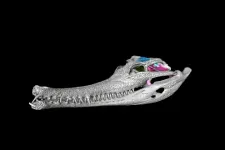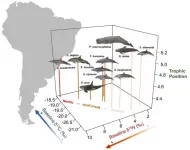(Press-News.org) PLYMOUTH MEETING, PA [July 6, 2021] -- New research in the June 2021 issue of JNCCN--Journal of the National Comprehensive Cancer Network assesses the quality of cancer care delivered through extended sites coordinated by some of the country's largest cancer centers. The study was developed to implement strategies for disseminating discoveries and expanding access to the highest quality cancer care as part of AACI's Network Care Initiative, established by former AACI President Stanton L. Gerson, MD, Director of the Case Comprehensive Cancer Center. Results were calculated based on responses to a mixed-methods survey answered by 69 cancer centers between September 2017 and December 2018, at which time 56 reported at least one network practice site.
Just over half indicated that network sites had full access to the main centers' electronic medical records (EMRs), and even fewer main centers had complete access to records throughout their network sites.
"Our findings demonstrate the need to improve network site alignment, particularly in patient navigators, care paths, and clinical trial access," said Dr. Gerson, the study's lead researcher and interim dean of the Case Western Reserve University School of Medicine. "Most federal cancer center reviews do not assess the total population of cancer patients served by major cancer centers and their affiliated sites. These data suggest that a very sizable portion of new cancer cases are cared for by these centers and their networks. Greater cancer center/network coordination could ultimately lead to improved access to clinical trials for the underrepresented communities many of these network sites serve."
According to the survey results, some key opportunities to improve coordination of care include:
Implementing integrated EMRs across networks;
Reviewing best clinical care practices, with more rigorous use of care paths and coordination of diagnosis and treatment planning across sites;
Greater attention and support for cancer clinical trials across network sites; and
Improved physician oversight of clinical and research expectations, hiring, review and other links with cancer center main campus sites.
"Many studies show that consistency through care plans and guidelines improves patient outcomes, clinical response, and survival. More proactive approaches, including care paths, tumor boards across networks, and recognition of the value of placing disease experts at network sites, will improve the standardization of care across sites," Dr. Gerson added.
"Disparities in cancer care outcomes, most significantly patient survival, have been shown between NCI-designated cancer centers and community hospitals, where two-thirds of cancer patients are cared for in the U.S." commented Lawrence N. Shulman, MD, Deputy Director for Clinical Services at the Abramson Cancer Center at the University of Pennsylvania, who was not involved in this research. "Rural cancer programs often have limited cancer physicians representing all relevant specialties and urban safety-net hospitals often have limited financial resources to support high-quality cancer programs. Partnerships between academic cancer centers and community and safety-net hospitals have the potential to improve outcomes for a broader spectrum of cancer patients in the U.S. One might consider support of these cancer programs an obligation of academic cancer centers. This study outlines some potential mechanisms of support."
The COVID-19 pandemic, which began well after this survey closed, and the growing call for increasing diversity in clinical trials, is also driving the need to better integrate network sites as a tool for delivering quality care to underserved populations. On June 7, NCCN presented a webinar on "Utilization of Network Satellite Locations" as part of a series on COVID-19 and Cancer Center Operations. Dr. Shulman was one of the panelists, along with other members of the NCCN Best Practices Committee. That video is available at: NCCN.org/covid-19.
INFORMATION:
To read the entire study, visit JNCCN.org. Complimentary access to "Status of Cancer Care at Network Sites of the Nation's Academic Cancer Centers" is available until September 10, 2021.
About JNCCN--Journal of the National Comprehensive Cancer Network
More than 25,000 oncologists and other cancer care professionals across the United States read JNCCN--Journal of the National Comprehensive Cancer Network. This peer-reviewed, indexed medical journal provides the latest information about innovation in translational medicine, and scientific studies related to oncology health services research, including quality care and value, bioethics, comparative and cost effectiveness, public policy, and interventional research on supportive care and survivorship. JNCCN features updates on the NCCN Clinical Practice Guidelines in Oncology (NCCN Guidelines®), review articles elaborating on guidelines recommendations, health services research, and case reports highlighting molecular insights in patient care. JNCCN is published by Harborside. Visit JNCCN.org. To inquire if you are eligible for a FREE subscription to JNCCN, visit NCCN.org/jnccn/subscribe. Follow JNCCN on Twitter @JNCCN.
About the National Comprehensive Cancer Network
The National Comprehensive Cancer Network® (NCCN®) is a not-for-profit alliance of leading cancer centers devoted to patient care, research, and education. NCCN is dedicated to improving and facilitating quality, effective, efficient, and accessible cancer care so patients can live better lives. The NCCN Clinical Practice Guidelines in Oncology (NCCN Guidelines®) provide transparent, evidence-based, expert consensus recommendations for cancer treatment, prevention, and supportive services; they are the recognized standard for clinical direction and policy in cancer management and the most thorough and frequently-updated clinical practice guidelines available in any area of medicine. The NCCN Guidelines for Patients® provide expert cancer treatment information to inform and empower patients and caregivers, through support from the NCCN Foundation®. NCCN also advances continuing education, global initiatives, policy, and research collaboration and publication in oncology. Visit NCCN.org for more information and follow NCCN on Facebook @NCCNorg, Instagram @NCCNorg, and Twitter @NCCN.
The braincase of crocodylians has a distinctive structure. Unlike evolutionary relatives (birds and squamates), in crocodylians, all braincase bones are rigidly fixed together and form an akinetic structure. In the process of evolution, this made it possible for animals to develop powerful jaws and stronger bite forces, thanks to which crocodylians could gnaw through the hard shell of crayfish and turtles and hunt fish and land animals, including dinosaurs. As a result, they have managed to fill the niche of predators and survive to the present day.
At present, in comparison with other parts of the crocodylian skull, the structure of their braincase has been understudied. This is because, until recently, scientists did not have ...
Dolphin species that live together, do not necessarily compete for food
A new molecular method reveals how different species of toothed whales compete for prey and which food they choose in each other's company. Marine scientists from NIOZ recently published their work in the scientific magazine Environmental Research.
Little is still known about the food and food search behaviour of toothed whales. What we know historically, is primarily derived from the stomach content of dead specimens. However, this makes it hard to actively study them in their natural habitat: you can't do more than wait for animals to wash ashore. Consequently, ...
Many standard economic models assume people make perfectly rational, individual decisions. But new research suggests economic phenomena like inequality and business cycles are better explained by models which recognize that people's decisions are affected by the decisions and the behaviors of people around them.
To show this, researchers built a model in which households are embedded in a social network that powerfully affects their savings decisions. This fairly simple model resulted in cyclical fluctuations resembling business cycles, as well as in emergent inequality - for instance, many poor households with low saving rates and a few rich households with high saving ...
* Clinical trial at University of Warwick compares the familiar cast, traditionally signed in sympathy, to modern removable brace for immobilising broken ankles
* Cast was not more effective, with patients reporting similar levels of pain and functionality, suggesting that choice should be down to patient preference and cost effectiveness
* Some data suggested a patient preference for the removable brace - sometimes referred to as the 'Beckham boot' after David Beckham
Using a cast is not more effective than a brace for treating broken ankles, according to University ...
An elegant new algorithm developed by Danish researchers can significantly reduce the resource consumption of the world's computer servers. Computer servers are as taxing on the climate as global air traffic combined, thereby making the green transition in IT an urgent matter. The researchers, from the University of Copenhagen, expect major IT companies to deploy the algorithm immediately.
One of the flipsides of our runaway internet usage is its impact on climate due to the massive amount of electricity consumed by computer servers. Current CO2 emissions ...
Medical researchers at Ludwig-Maximilians-Universitaet (LMU) in Munich have uncovered how signal proteins of the immune system regulate the development of atherosclerosis.
Atherosclerosis is one of the most common causes of death in Germany. The condition is characterized by the build-up of cholesterol and other fatty metabolites in the arterial wall directly below the endothelial cell layer, which is in direct contact with the bloodstream. This process results in constriction of the artery, which obstructs blood flow and can trigger heart attacks and strokes. Atherosclerosis is generally treated with drugs that reduce the concentration of lipids in the circulation, often using compounds called statins. However, statins effectively reduce the risk of cardiovascular ...
Dysmenorrhea, that is, frequent severe and painful cramps during menstruation from abnormal contractions of the uterus, is the most common of all gynecological disorders. It affects between 16-91% of girls and women of reproductive age, of whom 2%-29% have symptoms severe enough to restrict their daily activity. Now, for the first time, researchers from China Medical University Hospital in Taiwan have shown that long-term exposure to air pollutants such as nitrogen and carbon oxides and fine particulate matter greatly raises the risk of developing dysmenorrhea. Based on long-term data on air quality and public health from national databases, they show that the risk to develop dysmenorrhea ...
A study led by University of Barcelona researchers and carried out together with more than 1,650 students and their family members from 18 educational centres in Barcelona shows that citizen science is a valid approach able for doing high quality science, and in this case, able to provide nitrogen dioxide values with an unprecedented resolution and to assess the impact of the pollution in the health of their inhabitants.
The journal Science of the Total Environment has published the results of a study carried out by the research group OpenSystems of the University of Barcelona, the Barcelona Institute for Global Health (ISGlobal), promoted by La Caixa Foundation ...
Participants at the 6th Joint Science Conference of the Western Balkans Process have developed a "10 Point Plan" to control the coronavirus pandemic in the Western Balkans. Participants at the virtual two-day meeting also discussed priorities for the time after the pandemic in the Western Balkans and South East Europe. These include a decent healthcare system, climate neutrality, reduction of air and water pollution, and the digitalization of education, public administration, industry and healthcare. The conference was jointly organized by the German National Academy of Sciences Leopoldina and the Polish Academy of Sciences as part of the Western Balkans ...
Although hypomorph mammals (or equids) are currently represented by only one genus ('Equus') and just a handful of species of horses, donkeys and zebras, they were more diverse during the Eocene epoch (between 56 and 33.9 million years ago). One of the most widespread groups in Europe, which was an archipelago at that time, were the palaeotheriidae, named after the genus 'Palaeotherium', described in 1804 from fossils originating in the quarries of Montmartre (Paris) by the famous French naturalist George Cuvier.
The international Journal of Vertebrate Paleontology has recently published a paper on a study led by Leire Perales-Gogenola describing two new species of palaeotheriidae mammals that inhabited the subtropical landscape of Zambrana (Álava) ...





